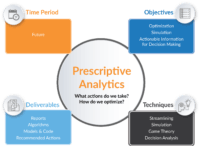Prescriptive analytics is a branch of data analytics that uses prescient (predictive) models to propose actions for ideal results. Prescriptive analytics is associated with both prescient and descriptive analytics. While prescient analytics figures what might happen, and descriptive analytics provides data into what has happened, prescriptive analytics helps provide the best results among different choices, given the known parameters. Prescriptive analytics stretches out past prescient analytics by indicating both the activities important to accomplish anticipated results, and the interrelated impacts of every choice.


Prescriptive analytics utilizes recent advancements such as machine learning and artificial intelligence to comprehend what the effect is of future choices and utilizes those situations to determine the best results. Advancements in the computing speed and the development of complex mathematical algorithms connected to informational indexes have made prescriptive analysis conceivable. Specific procedures used in prescriptive analytics include streamlining, simulation, game theory, and decision-analysis methods.
Application of Prescriptive Analytics
Prescriptive analytics is utilized in situations where there are an excessive number of choices, factors, requirements, and information for the human mind to proficiently assess without technology assistance. It is likewise utilized when testing in the real world would be prohibitively costly, excessively hazardous, severely time-consuming.
In a perfect state, any business issue would experience every one of these stages (Descriptive, Predictive, and Prescriptive) to ascertain a solution. In any case, there are certain business issues that absolutely require prescriptive analytics, such as:
- Supply Chain Optimization
- Logistics is the biggest consumer of this form of analytics. It utilizes network flow modeling to resolve transshipment issues, shortest path issues, maximal flow issues, transportation/assignment problems, and generalized network flow problems. It involves minimizing the cost of risk while getting from source to destination.
- Operations Management
- It uses linear and, more often, nonlinear programming to outline and control the process of generation and redesigning business activities in the production of goods or services. It includes minimizing throughput or maximum output of the whole task/process.
- Inventory Management
- Here, it’s all about setting generation levels and stock levels to meet forecasted demand at sales locations. How much should each plant supply to each distribution center? Which stockrooms should serve which sales locations? The list goes on.
- Price Optimization
- Organizations can be confident in making pricing decisions because prescriptive analytics helps organizations identify and understand patterns and insights.
Benefits
The benefits of including prescriptive analytics as part of your analytics hub can be outlined as follows:
- Anticipates what will happen, when something will happen, and why it will happen
- Suggests choice alternatives to exploit a future opportunity
- Mitigates a future hazard
- Ingests new data to re-predict and re-recommend, thus automatically improving forecast precision and endorsing better decision options without compromising other priorities
- Automatically and reliably processes up-to-date data to improve the accuracy and efficiency of predictions, and to give better decision choices
- Predicts various prospects and enables organizations to evaluate various conceivable results in light of their activities
Conclusion
Prescriptive analytics is the prospective of Big Data, but it is as yet far away before it will be common language. The potential is colossal; however, it requires gigantic measures of information to be able to make correct decisions. Only a handful of organizations and industries have that measure of information and informational indexes to make something useful out of prescriptive analytics. However, in 5-10 years, prescriptive analytics will be as typical as business intelligence today. Gartner gauges the prescriptive analytics software market will reach $1.1 billion by 2019.
Mastech InfoTrellis – a pioneering data and analytics company – is a leader in the implementation and use of advanced analytics applications across a wide array of industries.
Get in touch today to learn more about how you can take advantage of this new wave of analytics and gain actionable insights through a relevant, powerful analytics hub. Improve your organization’s decision-making capabilities today.

Garima Jain
Technical Consultant, Mastech InfoTrellis




















